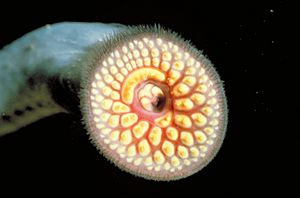Silver lamprey facts for kids
Quick facts for kids Silver lamprey |
|
|---|---|
 |
|
| Conservation status | |
| Scientific classification | |
| Kingdom: | |
| Phylum: | |
| Class: | |
| Order: | |
| Family: | |
| Genus: |
Ichthyomyzon
|
| Species: |
I. unicuspis
|
| Binomial name | |
| Ichthyomyzon unicuspis C. L. Hubbs & Trautman, 1937
|
|
| Synonyms | |
|
|
The silver lamprey (Ichthyomyzon unicuspis) is a type of lamprey. You can find it in the northern and Central United States, and also in a large part of southern Canada. Its scientific name means "sucking fish" in Greek and "one-pointed" in Latin.
The silver lamprey belongs to a group of fish called Agnatha. These are sometimes called cyclostomes, which means "round-mouths." Other common names for this animal include Bloodsucker, Blue Lamprey, and Lamprey Eel. It is important not to confuse the silver lamprey with the sea lamprey (Petromyzon marinus). Sea lampreys have caused a lot of harm to fish in the Great Lakes region.
Contents
Where Silver Lampreys Live
Silver lampreys are often found near the Great Lakes. They also live in the Mississippi River and Ohio River. You can find them in smaller rivers that flow into these big ones. This includes areas from Minnesota to Nebraska, Tennessee, and West Virginia. A few have also been seen near the Hudson Bay. Some have even been found in the Mississippi River in Mississippi.
What Silver Lampreys Look Like
The silver lamprey looks like an eel. It has a long, thin body with about 49 to 52 clear sections. These sections are called myomeres. Adult silver lampreys usually grow to be about 12 inches long. When they are ready to lay eggs, they are silvery or bluish. Before that, they are often a dull brown or tan color.
They have one long fin on their back called a dorsal fin. This fin might have a small notch in it. Their mouth is a jawless, sucking disc. It has sharp, single-pointed teeth arranged in circles. When the mouth is open, it can be wider than the lamprey's body. The lamprey's gills are in a straight line behind its eye. It has one nostril between its eyes.
Baby lampreys are called ammocoetes. They are brown to tan all over. They do not have eyes, but they do have eyespots. Ammocoetes have seven gill openings. They do not have paired fins, only a long fin that goes from their back to their belly. They also have no teeth. Instead, they have an oral hood. This hood has skin extensions that help them filter tiny bits of food from the water.
Silver Lamprey Homes
Adult silver lampreys like clear water. They prefer large streams, rivers, and lakes. When it's time to lay eggs, adults move to flowing water. They look for areas with rocky or gravelly bottoms.
When the babies hatch, they move to slow-moving water. Here, they find thick layers of organic material. As they grow, they move to sandy areas. They will stay there until they change into adults.
What Silver Lampreys Eat
Adult silver lampreys are parasitic. This means they feed on the blood of other fish. Most lampreys that are not parasitic only eat when they are babies. Then they die.
Silver lampreys use their sucking mouths to attach to their host fish. Then, they use their teeth to cut through the skin and scales. The lamprey stays attached to the host for a long time. However, they usually do not kill their host. This is because the host fish have learned to live with these lampreys over time.
Adults eat many kinds of fish. These include trout, whitefish, smelt, pike, white sucker, brown bullhead, rock bass, walleye, and the armored lake sturgeon. The young lampreys, called larvae, eat tiny floating plants and animals. They also eat dead bits of plants and animals in the water.
Reproduction and Life Cycle
Adult silver lampreys swim upstream to lay their eggs. This happens in May and June. The water temperature needs to be about 50 degrees Fahrenheit. They use their mouths to move sand and gravel. This helps them dig a nest in the stream bed. After they lay their eggs in the nest, the adult lampreys die.
When the eggs hatch, the babies are called ammocoetes. They are blind and have no teeth. They have a special tissue that acts like a fine sieve. They float downstream and then burrow into the sand, mud, and organic material. They stay there for 4 to 7 years. During this time, ammocoetes mostly eat dead plants and algae.
When they are about four to five inches long, the ammocoetes change into parasitic adults. This change is called metamorphosis. Then, they swim downstream to find host fish to feed on. After feeding as a parasite for one to two years, adult silver lampreys swim upstream to lay their eggs and then die.



